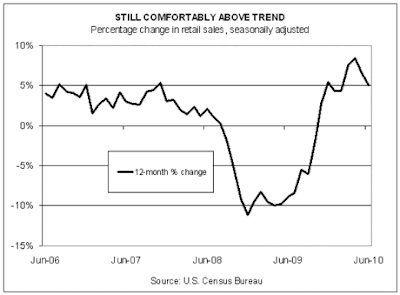Today’s update of retail sales for June doesn’t look good, but it’s still not so bad in terms of the broader trend. That doesn’t mean that there’s nothing to worry about, but for the moment the annual pace of retail sales is still comfortably in positive territory. But given the current climate, more downshifting may be coming. At what point does a return to trend signal something worse? It’d be foolish to underestimate the hazards these days, but the economy’s fate is not yet doomed, or so the trend in retail sales imply.
On a monthly basis, the news is less encouraging. Seasonally adjusted retail sales dropped last month by 0.5%, the second straight monthly decline. But that’s hardly the end of the world, considering that retail sales rose in each of the first four months of this year. On a monthly basis, this is a noisy number and so it's not yet clear that sustained losses are destiny.
On a rolling 12-month basis, retail sales are still up sharply, as the chart below shows. For the year through June, total sales are higher by 5%. That’s at the top range of the glory days in the years ahead of the Great Recession. What this chart tells us is that the annual pace of retail sales can still drop in the months ahead without turning bearishly fatal.

Even so, there are still plenty of reasons to stay cautious on what comes next. If we review retail sales in terms of seasonally adjusted dollars spent, for instance, the trend looks quite a bit more intimidating. In our second chart below, it’s hard to miss the hefty decline in consumer spending of late. Although retail sales are up sharply in absolute dollars from a year ago, it looks like the rebound peaked in April 2010. For the moment, we’re nowhere near the previous top, nor are we likely to return to those heights anytime soon. In that sense, the chart below is a graphic symbol of the times--diminished expectations and deflated economic activity.

Retails sales, of course, are but one measure in a sea of economic numbers. In an effort to bring some clarity to the broader economic trend, I publish an equally weighted index of 18 economic statistics in The Beta Investment Report, as listed in the table below, which is republished courtesy of the July issue of the newsletter.

Unsurprisingly, the BIR Economic indices have been falling recently, reflecting the rise in deflationary risks lately, as we discussed here and here, for example. But economic news arrives with a lag, of course, and so forecasting the broad trend is that much more difficult. For instance, the last full month with all the 18 economic reports published was May. Meantime, June data continues to roll in, including today’s retail sales report. So far, eight of the 18 data points for June have arrived. Unfortunately, five of the eight posted declines last month vs. May; one is unchanged; and one is higher. It’s not yet clear that the economic weakness of late is set to end.

The lone gain so far for the June data, however, is encouraging. Commercial & Industrial loans turned up last month—the first increase since October 2008, according to the latest round of revised data from the Federal Reserve. The news that lending is moving higher is good news, of course. New loans are essential in the grand scheme of the business cycle for planting the seeds of growth. Lending in the private sector by itself is hardly a silver bullet, but it’s a fundamental part of every recovery.
Alas, the uptick in June, welcome as it is, is slight. As increases in C&I loans go on a monthly basis, the 0.02% rise could hardly be much smaller. But for the moment, that’s all we’ve got. The question is whether we’ll see anything better anytime soon?
This article has been republished from James Picerno's blog, The Capital Spectator.
No comments:
Post a Comment